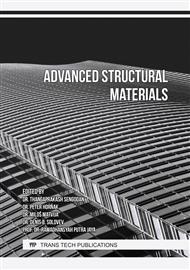p.161
p.167
p.175
p.183
p.191
p.197
p.203
p.209
p.215
Molecular Dynamics Simulation of Structural Properties of Hydrated Tobermorite
Abstract:
The paper studies the geometric optimization and elastic moduli of Ca24Si22O52(OH)16(H2O)28 supercells with 28 water molecules embedded at different degree angles. The water molecule embedment in the supercell is performed by the molecule rotation about X, Y and Z axes to the required angle. It is shown that the position of water molecules significantly affects the internal energy, elastic properties and stability of the optimized supercell and the geometry of its crystal lattice. Supercells with water molecules embedded at 2, 4, 20, 80, 300, 354 and 356-degree angles are stable structures, and a supercell with water molecules embedded at a 20-degree angle turns to be much more stable. The refined structural parameters, lattice volumes, elastic moduli, and atom positions are determined for the geometrically optimized supercell states. Stable supercells can be included in Richardson’s crystallographic database with a view to use them as the reference standards in the Rietveld refinement of the structural properties of hydrated Portland cement with variable water content.
Info:
Periodical:
Pages:
215-220
Citation:
Online since:
March 2023
Authors:
Keywords:
Price:
Сopyright:
© 2023 Trans Tech Publications Ltd. All Rights Reserved
Share:
Citation:


